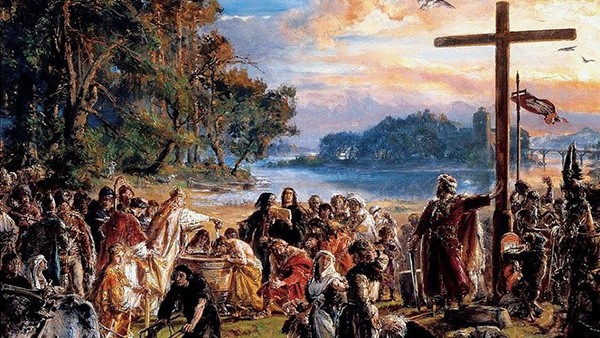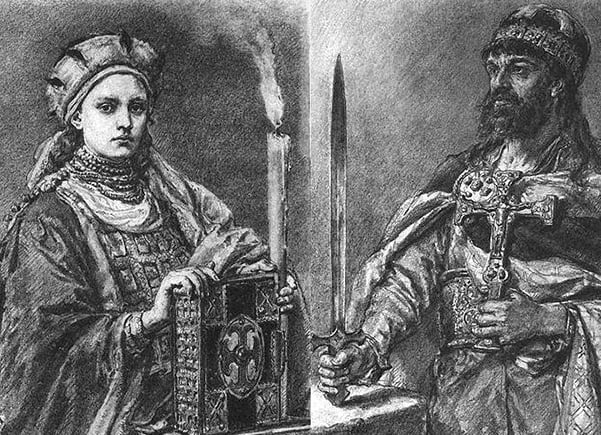
On April 14, 966 AD, a year after his marriage to the Christian Princess Dobrawa of Bohemia, the pagan ruler of the Polans tribe, Mieszko I, was baptized and converted to Christianity. This event is considered to be the founding of the Polish nation and marks the entry of Poland into the community of Western European Christian states.
As with most high-ranking marriages at the time, Mieszko’s was a political alliance, and the baptism was a political, rather than a spiritual, conversion. Some two years before his baptism, Mieszko began negotiations with the Bohemian ruler, Boleslav I the Cruel. Those negotiations resulted in Mieszko marrying Boleslav’s daughter, Dobrawa, sometime in 965. Because she was Christian, Mieszko was to be baptized, as part of the marriage agreement. This act would bring his state closer to the Bohemians, decrease the likelihood of attacks from German forces invading under the pretense of bringing Christianity to pagan nations, and neutralize the power of Poland’s influential pagan priests, who were blocking Mieszko’s efforts to centralize Polish rule. Though the exact date is unknown, it is believed that Mieszko was baptized on or around 14 April 966, which would have been Easter Monday of that year.

Jan Matejko, Christianisation of Poland, from the cycle of paintings History of civilisation in Poland, photo: National Museum in Warsaw
In accepting Christian baptism, Mieszko I effectively baptized the entire Polish nation. The consequences were considerable. Poland entered the community of Western European Latin-rite Christian states. He did this not only for spiritual and moral reasons, but for political and national security ones. The Holy Roman Empire–-as well as any other Christian country in Europe-–theoretically had the right to attack Poland under pretext of bringing Christianity to the Poles. By accepting Christianity, Mieszko neutralized that threat. Though the pagan priest caste in Poland organized many rebellions, and it was centuries before the majority of Poles followed suit and converted, Mieszko’s baptism invited the spread of Latin culture and literacy into Poland, moving the allegiance of the country towards the West (Europe), rather than the East (Russia), and this had enormous consequences throughout the history of Poland and determined its place in Europe over the last one thousand years. The Christianization of Poland restructured the state’s power elite, downgrading traditional tribal elders and pagan priests and upgrading incoming clergy who helped education, culture, and diplomacy to flourish in Poland, and placed it firmly in the sphere of Western European culture, traditions, and politics.
By the 13th century, Roman Catholicism became the dominant religion in Poland, although it did take over 200 years to accomplish this goal and to diminish pagan influences in the culture. Today, Poland continues to be a majority Catholic country and Poles celebrate the day that Christianity was introduced to the nation with many religious, cultural, and political observances.
During this 1050th anniversary year, many concerts, exhibitions, rallies, and religious observances are planned throughout Poland, with a visit by Pope Francis scheduled for late July, where he will participate in Krakow’s World Youth Days from July 26th to July 31st. The Pontiff will arrive in Poland on July 27th. In the U.S., the major event will be held at the Orchard Lake Schools in Michigan on June 22nd. Many other Polish American organizations, institutions, and parishes are planning observances and celebrations as well. Please let us know if your District, Council, or Group is organizing an event to celebrate the 1050th anniversary of Poland’s baptism and nationhood.

Mieszko I – Prince of Poland and his wife Princess Dobrawa
Mieszko I (ca. 940 – May 25, 992) was the ruler of the Slavic Polans tribe from about 960 AD until his death. A member of the Piast dynasty, Mieszko became the first Christian ruler of Poland and is considered the de facto creator of the Polish state. He continued the policies of his father and grandfather, who were rulers of the pagan tribes located in the area of present-day Greater Poland (Wielkopolska). Both through alliances and through the use of military force, Mieszko extended Polish conquests and, early in his reign, subjugated Kujawy, Gdansk, Pomorze, and Mazowsze and made them part of the Polish state. For most of his reign, Mieszko was involved in warfare for the control of Western Pomerania (Zachodnie Pomorze), eventually conquering it up to the vicinity of the lower Oder River. During the last years of his life, he fought the Bohemian state, winning Silesia (Slask) and Lesser Poland (Malopolska).
Mieszko’s marriage in 965 to the Bohemian princess Dobrawa and his baptism in 966 put him and his country firmly in the cultural sphere of Western Christianity. Apart from the great conquests accomplished during his reign (which proved to be fundamental for the future of Poland), Mieszko was also renowned for his internal reforms. On his death in 992, he left to his son, Boleslaw Chrobry, the first crowned king of Poland, a country with greatly expanded territories and a well-established position in Europe.
